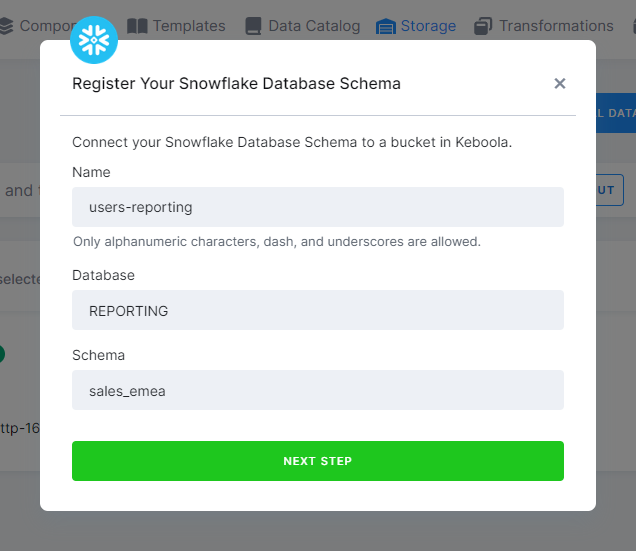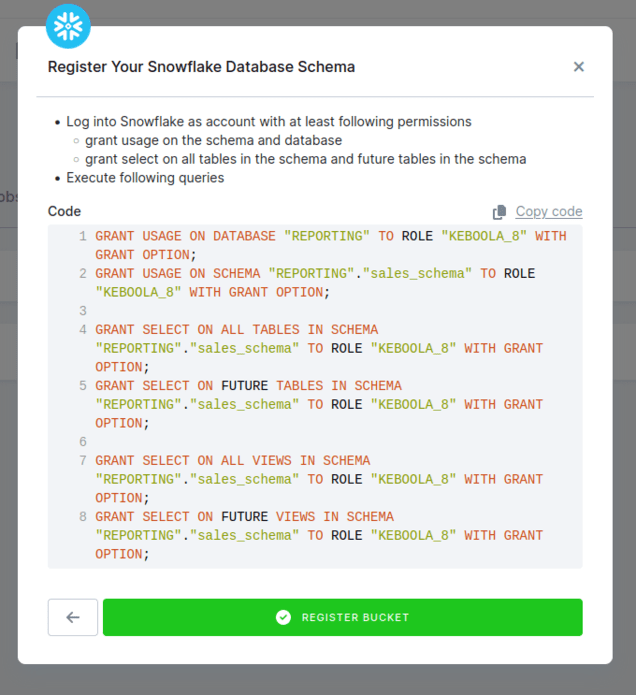External Buckets
- What Is an External Bucket?
- Creating an External Bucket
- Using an External Bucket
- Removing an External Bucket
- Usage Recommendations
- Limitations
If you operate Keboola in Bring Your Own Database (BYODB) mode atop your own data warehouse, the data residing in the warehouse will not automatically be visible or accessible from inside Keboola. We address this by providing the External Buckets feature.
The exact implementation of external buckets depends on your database backend; it could be a database, schema, or another concept. Unless stated otherwise, we will describe the implementation for Snowflake.
The External Buckets feature is available only in BYODB mode. To enable it, please contact our support team.
Public Beta Warning:
This feature is currently in public beta. Please provide feedback using the feedback button in your project.
What Is an External Bucket?
Storage in Keboola is organized into buckets. An external bucket is a special type of bucket wherein Keboola does not manage the bucket’s contents. It can be located anywhere in the storage backend used by your Keboola project (Snowflake or BigQuery) and is a virtual bucket created atop a Snowflake schema or BigQuery dataset, respectively. All table-like objects (such as tables, views, and external tables) inside the schema are mapped to tables in the bucket. Access to the bucket is read-only; you cannot write to the bucket from Keboola. A single schema can be registered simultaneously with multiple projects in Keboola.
Creating an External Bucket
An external bucket can be created in the Storage section of the project.

Click on the Register External Data button. The dialog will differ based on the backend you are using.
Snowflake
Fill in the name of the new bucket, database name, and schema name.

Then, continue to the next step, where we will provide you with a guide on correctly granting Keboola access to the schema in Snowflake.

Note: This set of permissions grants the Keboola service account read-only access to the data.
Data shared via Snowflake is currently not supported. Attempting to grant permissions will result in an error.
Read-only input mapping with external buckets has a limitation. If you delete and recreate a registered table in the source schema,
our read-only input mapping will lose access to this table.
This occurs because we aim to limit clients from having excessive permissions, such as OWNERSHIP, on their external schemas.
However, manually refreshing the bucket addresses this issue.
To permanently resolve this issue, you can manually grant the read-only input mapping role future access to your tables as illustrated below:
GRANT SELECT ON FUTURE TABLES IN SCHEMA "REPORTING"."sales_schema" TO ROLE KEBOOLA_8_RO
Ensure the role name follows the pattern in the picture and is suffixed with _RO.
Once you are done, click Register Bucket to start using it.
BigQuery
Fill in the name of the new bucket and dataset name.

Then continue to the next step, where we will provide you with a guide on correctly granting Keboola access to the dataset in BigQuery.

Note: By adding the Keboola service account as a subscriber, you enable read-only access to the data.
We only support BigLake external tables. Please ensure the table you are using is of this type. External tables of other types not work in transformations and workspaces.
Once you are done, click Register Bucket to start using it.
Considerations
When you register an external bucket, we analyze the metadata of objects in it and register all tables and views as tables in the bucket in Keboola. If you later add additional tables or views, you must manually refresh the external bucket using the Refresh action in the bucket detail to make them visible in Keboola.

Using an External Bucket
External buckets are not part of a normal input mapping. They are accessible via the read-only input mapping. Keep in mind that external buckets cannot be used in an output mapping as they are not writable.
External Bucket in a Snowflake SQL Transformation
Because external buckets are not part of a normal input mapping, they are not copied into your transformation workspace. You need to reference them in your transformation using a fully-qualified name.
In the following example, you’ve created an external bucket called users-reporting that references the sales_emea schema in the database REPORTING. The schema contains a table called users. You want to create a new table MQL_USERS that contains only users sourced from marketing-qualified leads. You can do that using the following SQL:
CREATE TABLE "MQL_USERS" AS SELECT *
FROM "REPORTING"."sales_emea"."users"
WHERE "source" = 'mql';
Note: The query uses the fully-qualified name of the table in the FROM clause.
External Bucket in a BigQuery SQL Transformation
In BigQuery, the external bucket is mapped to an actual dataset, users_reporting (the name you filled in the dialog), in your project – in this case, project sapi-9752.
You can reference the contents of the dataset in your SQL transformation using a fully-qualified name.
CREATE TABLE `MQL_USERS` AS SELECT *
FROM `users_reporting`.`users`
WHERE `source` = "mql";
The dataset name is the name of the bucket you provided in the dialog (users-reporting), not that of the original dataset created in BigQuery (sales_emea). However, there are no technical limitations; they can have the same name.
Removing an External Bucket
Removing an external bucket is as simple as removing any other bucket. Simply delete it in the UI or via API. The bucket will be removed from the project, but the schema in the database will remain untouched. If you wish to remove the schema, you must do so manually in your warehouse. You may want to revoke the grants to Keboola to ensure that Keboola no longer has access to it.
Usage Recommendations
- Use external buckets to consume data in your warehouse produced by 3rd-party tools outside of Keboola.
- Use external buckets to access data in table-like structures that are not directly supported by Keboola (e.g., views or external tables).
- Using external buckets to load data from services with existing components into Keboola is discouraged. Consider the following limitations of such an approach:
- You would have to orchestrate, maintain, and monitor the external pipeline, which Keboola normally does for you.
- Manipulation of the data will not be tracked in the Keboola audit trail.
- Event-driven triggering is not supported for external buckets, so you must manually synchronize the external and Keboola pipelines based on time.
- While there are legitimate uses of external tools, keep in mind that by having data pipelines outside Keboola, you lose the main benefit of Keboola – the ability to orchestrate, maintain, monitor, and audit the pipelines in one place.
Limitations
- Table names in the external buckets can’t be longer than 92 characters and can contain only alphanumeric characters, dashes, and underscores. Tables that do not meet these requirements will be ignored.
- Table names are not case-sensitive. You cannot create two tables with the same name that differ only in letter case.
- Creating snapshots from tables in external buckets is not supported.
